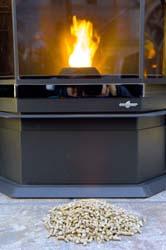Sawdust pellets: Difference between revisions
Jump to navigation
Jump to search

imported>George Swan (add image) |
imported>George Swan |
||
| Line 16: | Line 16: | ||
| work = [[Consumer Reports]] | | work = [[Consumer Reports]] | ||
| date = 2021-02-23 | | date = 2021-02-23 | ||
| accessdate = 2021-03-12 | |||
| quote = Pellet stoves offer a more environmentally sustainable choice for homeowners; the units burn recycled sawdust that’s been compressed and dried. You fill a hopper with pellets, set the heat level, and the stove automatically ignites. An electrically powered auger continuously feeds the pellets into the stove’s firebox. | | quote = Pellet stoves offer a more environmentally sustainable choice for homeowners; the units burn recycled sawdust that’s been compressed and dried. You fill a hopper with pellets, set the heat level, and the stove automatically ignites. An electrically powered auger continuously feeds the pellets into the stove’s firebox. | ||
}} | }} | ||
| Line 27: | Line 28: | ||
| work = [[Granite Greek]] | | work = [[Granite Greek]] | ||
| date = 2020-11-08 | | date = 2020-11-08 | ||
| quote | | accessdate = 2021-03-12 | ||
| quote = But if you can’t switch to an automated wood heat system, you can still reduce your greenhouse gas impact by using a conventional pellet stove, which helps you reduce your fossil fuel consumption. In either case, using wood pellets from northern New England or New York is key; their climate impact is less than pellets from elsewhere that are transported long distances to the mill and to the end user. | |||
}} | }} | ||
</ref> | </ref> | ||
| Line 38: | Line 40: | ||
| work = [[Arkansas Online]] | | work = [[Arkansas Online]] | ||
| date = 2020-12-10 | | date = 2020-12-10 | ||
| accessdate = 2021-03-12 | |||
| quote = Reilly said wood is not only renewable, but leaves behind far less toxic waste than coal, which not only lowers the environmental impact, but makes it less costly overall. | | quote = Reilly said wood is not only renewable, but leaves behind far less toxic waste than coal, which not only lowers the environmental impact, but makes it less costly overall. | ||
}} | }} | ||
| Line 48: | Line 51: | ||
| work = [[Environmental Protection Agency]] | | work = [[Environmental Protection Agency]] | ||
| date = | | date = | ||
| accessdate = 2021-03-12 | |||
| quote = Technologies are used to ensure the best fuel‐to‐air ratio in the combustion chamber so that the fuel can burn completely. | | quote = Technologies are used to ensure the best fuel‐to‐air ratio in the combustion chamber so that the fuel can burn completely. | ||
}} | }} | ||
Revision as of 18:15, 12 March 2021
Sawdust pellets are an alternate fuel, made from compressed sawdust, or from other lumber byproducts, or related byproducts, like cherry pits.[1] Sawdust was a byproduct of turning raw wood into manageable sized lumber.
Users of pellet fuel usually use special pellet stoves, built to burn pellets.[1] Pellet fuel is described as having a smaller environmental impact than older alternatives, like coal.[2]
Due to their standard size, pellet stoves can be designed to burn their fuel more precisely, so the combustion produces less harmful smoke.[3][4] Due to their standard size, pellet stoves can be fueled from a hopper, and automate the longer term management of a large supply of pellets.
References
- ↑ 1.0 1.1 Tobie Stanger. Consumer Reports' Guide to Pellet and Wood Stoves: Improved efficiency and safety—plus a new tax credit—add to the allure of these home heaters, Consumer Reports, 2021-02-23. Retrieved on 2021-03-12. “Pellet stoves offer a more environmentally sustainable choice for homeowners; the units burn recycled sawdust that’s been compressed and dried. You fill a hopper with pellets, set the heat level, and the stove automatically ignites. An electrically powered auger continuously feeds the pellets into the stove’s firebox.”
- ↑ Dale Ellis. Pellet mill expanding with investor tie-up, Arkansas Online, 2020-12-10. Retrieved on 2021-03-12. “Reilly said wood is not only renewable, but leaves behind far less toxic waste than coal, which not only lowers the environmental impact, but makes it less costly overall.”
- ↑ David Brooks. Study: Switching from heating oil to local wood cuts greenhouse gasses, Granite Greek, 2020-11-08. Retrieved on 2021-03-12. “But if you can’t switch to an automated wood heat system, you can still reduce your greenhouse gas impact by using a conventional pellet stove, which helps you reduce your fossil fuel consumption. In either case, using wood pellets from northern New England or New York is key; their climate impact is less than pellets from elsewhere that are transported long distances to the mill and to the end user.”
- ↑ Pellet Stove Fact Sheet, Environmental Protection Agency. Retrieved on 2021-03-12. “Technologies are used to ensure the best fuel‐to‐air ratio in the combustion chamber so that the fuel can burn completely.”
